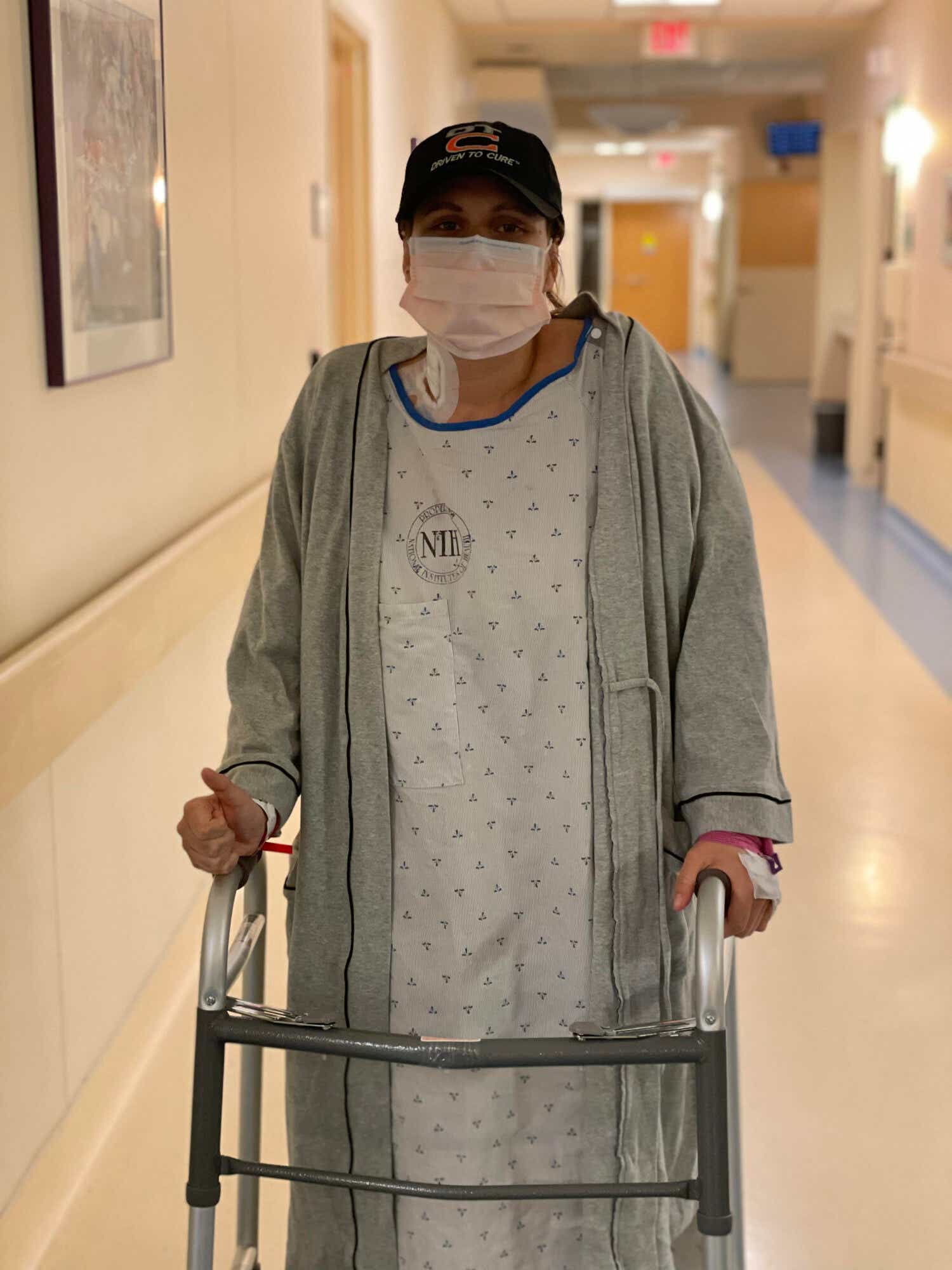Katie Coleman feels numb. She’s sitting in an office across from her doctor. His mouth is moving, but she can’t hear what he’s saying anymore. Her brain stopped processing after she heard the words “Stage IV kidney cancer.”
Next to Coleman sits her husband; he’s holding her hand and crying. Katie is 29 years old, and the couple has only been married for two months. They’d been thinking about starting a family. He certainly didn’t sign up for this, she thinks.
I had a new career and a wonderful husband. We were building our dream home and planning to start a family. And then everything just crumbled.
Katie Coleman
Two months earlier, Coleman had been in the prime of her life. It was the height of the pandemic, so she and her fiance decided to elope, with Coleman’s best friend performing the ceremony and their photographer as their witness. “Everything was finally perfect in my life,” recalls Coleman. “I had a new career and a wonderful husband. We were building our dream home and planning to start a family. And then everything just crumbled.”

About a year and a half before she got married, Coleman had started noticing some strange symptoms. She had extremely high blood pressure, which was odd for a woman her age. Her heart rate was alarmingly high, and she’d started getting abdominal pain. She saw a few specialists, who told her she was likely experiencing anxiety and menstrual cramps. “This was during the pandemic, so a lot of these were telehealth appointments,” says Coleman. “Everyone just told me I was anxious, and I didn’t know how to verbalize that this was something different.”
Since Coleman and her husband were thinking of having a child, she visited a doctor to ask about her cramping. Coleman let the doctor know about another strange symptom: She’d developed a hard mass on her upper right abdomen. Her doctor was unconcerned about the mass, and she was sent home. But Katie was concerned — the mass wasn’t going away. So she went to urgent care and let them know she suspected she had an enlarged liver.
“They sent me for an ultrasound, and there it was,” she remembers. “It” was a 12-centimeter tumor, roughly the size of a softball, engulfing her kidney. She would later learn that she had about 15 additional tumors in her liver.
“I had run this scenario through my mind a hundred times, and I expected I’d be terrified,” recalls Coleman of the moment she saw the tumor. “But the very first emotion I felt was actually relief. Finally somebody believed me, and that was validating.”
The moment I was diagnosed, I felt this overwhelming sadness that I’d brought him into this nightmare. I wasn’t just robbed of my own future, I was robbing him of his.
Katie Coleman
Then, the fear hit: not for herself, but for her family. “My husband and I got married very quickly because we’d grown so close during Covid,” says Coleman. “So the moment I was diagnosed, I felt this overwhelming sadness that I’d brought him into this nightmare. I wasn’t just robbed of my own future, I was robbing him of his.” But the man she’d married had promised to stay with her in sickness and in health, and he wasn’t going anywhere.
The tumor in Coleman’s kidney was known as an oncocytoma, which is typically known to be benign. She’s one of only a handful of known cases to have a malignant form. Since there was no data available on Coleman’s cancer, doctors weren’t sure how to proceed. “The worst part was the uncertainty,” says Coleman. “I didn’t know how to live my life, because I didn’t know how much time I had left.”

Coleman wasn’t aware at the time, but there was an entire organization devoted to researching cancers just like hers: the Rare Cancer Research Foundation (RCRF). For over a decade, the RCRF has worked to research and eradicate rare cancers by connecting patients and researchers across the country.
Unaware a resource like the RCRF existed, Coleman felt completely alone. “Even though my husband was my rock, there were certain things I couldn’t share with him,” she recalls. “I was so worried about how my death would affect him, but I couldn’t burden him with that.” During this dark time, Coleman sought out a support group of her own, connecting with other young women battling rare cancers. “We were all going through something similar, so we found ways to make each other laugh,” she remembers.
With nothing to lose, Coleman began doing her own research about her tumor online. As she learned more about her diagnosis, she began looking into surgery. It was an extremely risky option, and she struggled to find a surgeon to take her case. “I decided to connect with the NIH and National Cancer Institute for a specialist with experience in rare tumors. I found a surgeon who was willing to take a risk with the liver surgery. They took a chance on me.”
Doctors removed Coleman’s right kidney and five wedge resections of her liver. They were able to remove 15 of the tumors in the initial surgery, and 5 more in a second surgery. Then Coleman got some stunning news: Although it would be a long road to recovery, the surgeries had been successful, and there was no evidence of disease.
Unfortunately, Coleman’s success in finding a doctor who understood how to treat her rare cancer isn’t the norm. A major hurdle for rare cancer researchers is the small patient pool available, which inhibits them from using the best tool in a cancer researcher’s arsenal: DNA sequencing. By taking donated tissue from a patient’s tumor and sequencing DNA, cancer researchers can pinpoint the exact location of mutations in the sequence to determine how to treat the disease.
When you have a rare cancer like Katie’s, even the most brilliant scientists can’t test their theories.
Marshall Thompson
According to Dr. Marshall Thompson, a scientist and engineer working as President of RCRF, DNA sequencing for rare cancers is extremely difficult: “For a disease like lung cancer, which impacts millions of people, researchers have a huge pool of patients to collect data from,” Thompson explains. “When you have a rare cancer like Katie’s, even the most brilliant scientist can’t test their theories without access to a sizable group of patients or tissue samples.”
After struggling to connect researchers and doctors studying rare diseases, RCRF came up with a solution: a project they called Pattern. Pattern.org is an online consent platform that allows rare cancer patients, regardless of where they’re being treated in the U.S., to donate their de-identified living tissue samples and clinical data directly to cancer researchers studying their disease. Those researchers then place all the generated results into public repositories, so scientists worldwide have access. In addition, Pattern is launching a biobank to store tissue, and the data generated from it, for future projects.
To fund this enormous project, RCRF received support from the Chan Zuckerberg Initiative’s Rare As One Project. This project offers grants for patient-led organizations devoted to accelerating the science to eradicate rare diseases. With the help of funding from CZI, RCRF has been able to make their dream a reality.
After Coleman learned that with monitoring and additional treatment a longer-term outcome may be possible, she finally allowed herself to think about the future. After her harrowing experience, she reflected on the lack of support and resources available to survivors like her — and decided to devote her life to fighting rare cancer. At an oncology conference on rare cancers, Coleman met members of RCRF. Remembering how much she had needed an organization like RCRF while navigating her own rare cancer treatment, Coleman was determined to work with the organization. After hearing her story and reviewing her resume, RCRF offered Coleman her dream job: She would be their new Product Engineering Lead.
Reflecting upon her cancer journey, Coleman doesn’t dwell on the pain and uncertainty: she focuses on positive. “Before my surgery, I learned there was a risk I would need a blood transfusion, but the bank didn’t have enough blood,” she remembers. “I posted on social media about my case, and dozens of people turned up. A lot of them were strangers, but they showed up to donate for me. The blood bank said it was their largest turnout in history. Seeing that love gave me the strength to get through this.”
Editor’s note: It is with immense sadness that we announce the passing of Mark Laabs, RCRF’s founder and Chairman of the Board. Read more about Mark’s life and legacy.









